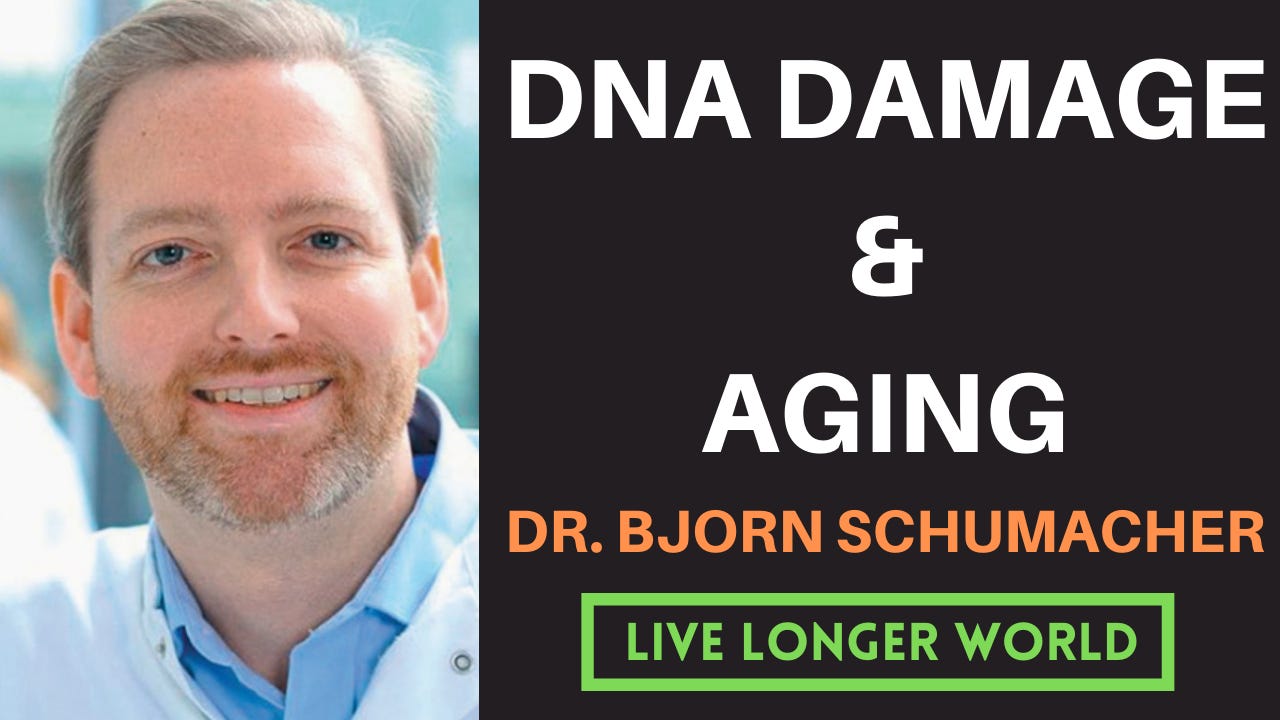DNA Damage & Aging | Dr. Bjorn Schumacher
Live Longer World Podcast #14
“DNA is the blueprint of life..And it’s really surprising how unstable the DNA is. It inflicts tens of thousands of lesions every single day. Every single cell in our body experiences about a 100,000 DNA lesions everyday, so it’s constantly occurring. It’s a fact of life that DNA is damaged and requires constant repair. And there are distinct repair mechanisms and when they fail people can age in an extremely accelerated fashion."Live Longer World Podcast Episode #14 has been released!
My guest today is Dr. Bjorn Schumacher whose work focuses on the central role of DNA damage in the aging process.
We discussed DNA damage accumulation with age, how DNA repair mechanisms play a role, how DNA damage in the reproductive cells can tell us a lot about aging, human fertility and reproductive capacity. We also discussed the role of p53 in cancer suppression, a new biological age clock being developed in his lab and how we should protect our skin from aging and thereby control DNA damage.
A lot of us have heard about the link between DNA damage and aging and this conversation really dives into it.
Dr. Schumacher is also the author of the book The Mysteries of Human Aging: Surprising Insights from a Science That’s Still Young.
FIND ALL LIVE LONGER WORLD PODCAST EPISODES:
Website | YouTube | Apple | Spotify | Google | All Platforms
Want Summarized Notes on Key Points Discussed in the Podcast?
Gain access by signing up as a premium subscriber. Your contribution supports my work and the advancement of longevity science!
Key points summarized below for premium subscribers include:
The central role of DNA damage in the aging process
What happens to our body’s DNA repair mechanism with age?
DNA Damage in the germ cells (reproductive cells) promotes stress resistance in the body
The role of p53 in suppressing cancer and in the DNA repair process
Listen to the Podcast:
Apple Podcasts:
Spotify:
YouTube:
All Platforms: here
Time Stamps:
0:00 Live Longer World Intro
0:30 Bjorn Schumacher Intro
1:22 DNA Damage as Central to the Aging process
3:37 DNA repair with age
8:39 Premature aging; 2 distinct forms of DNA damage
14:15 How does an aging human survive with DNA damage & tamp down cancer?
18:20 Stress to reproductive cells builds up immunity in the body
24:41 Female reproduction, Menopause & DNA repair
27:46 p53 and it’s role in DNA repair
35:13 BiT Clock: New Biological Age Clock
43:59 Skin Aging and DNA damage
48:06 Stress in the intestine / gut can alter the chromosome
53:00 Germ cells are immortal
Notable Quote:
“What is really exciting is that we have learned a lot about aging, about the genome, and the repair mechanisms that are required for healthy aging. We’ve learned particularly how complex this biology is, there is no quick fix to this. DNA damage occurs constantly all the time but we’ve learned much much better on this. We’ve gained fundamentally new insight into tissue cells repair, how they are maintained, how they interact with each other, how germ cells have such a profoundly high capability to repair the genome that they are essentially immortal, they can be passed on. In humans since 200,000 years of modern Homo Sapiens, we still are coming from the very same germ cells that our ancestors have passed on. There is a lot of opportunity to gain new insights, there is a lot of fundamental research that we are doing that is exciting that will lead to new breakthroughs. And I think we need to focus on expanding our fundamental knowledge of the biology of aging and the integrity of our genomes, and I think this is really where the major breakthrough will come from.”
Dr. Bjorn Schumacher Research Discussed:
2021 BiT age: A transcriptome-based aging clock near the theoretical limit of accuracy
2008 Delayed and Accelerated Aging Share Common Longevity Assurance Mechanisms
Summarized Show Notes of Key Points:
The central role of DNA Damage in the Aging Process
DNA is the blueprint of life and it’s surprising how unstable it is
There are 10s of 1000’s of DNA lesions that occur everyday
It is a fact of life that DNA is damaged and requires constant DNA repair
When the DNA repair mechanism fails, people can age very quickly
There are patients who carry mutations in their DNA repair genes and they show accelerated aging at a young age
There are many physiological changes in the body that are linked to DNA damage
Graphic: The central role of DNA damage in the aging process. Source: here
There are 2 really distinct outcomes of DNA damage. One is mutations that are known to cause cancer because they change gene expression and gene function. DNA damage is the cause of cancer development
DNA damage also causes cellular senescence. We need to start interfering upstream with the problem: one aspect is avoidance of genotoxins and another aspect is being able to target the molecular mechanisms to increase tolerance to DNA damage or augment DNA repair mechanisms
Calorie restriction has a major effect in slowing down DNA repair defects
The future is to mechanistically target DNA repair mechanisms and expand genome stability
How does the organism survive when there is damage to the DNA?
Keep reading with a 7-day free trial
Subscribe to Live Longer World to keep reading this post and get 7 days of free access to the full post archives.





